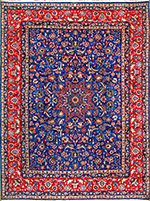Textiles Studies

Textile Research Works
Date of this Version
2001
Document Type
Article
Citation
Oriental Carpet and Textile Studies (2001)
Abstract
emerges from truth. Symmetry-breaking requires an expectation of symmetry. Often, symmetry-breaking is confused with asymmetry. But, rather, asymmetry is simply the absence of symmetry. For symmetry-breaking to exist, a pattern must first be stablished. Symmetry then is expected, but somehow that expectation is not met. There are many ways to effect symmetry-breaking in Oriental carpets. The study of Oriental carpets may lead one to suppose that in art, as in nature, it is in the approximation of symmetry, rather than in its precision, that beauty is to be found and appreciated. What is an Oriental Carpet? No one ever set out to weave an Oriental carpet. A woman, or a girl, or less often a young boy, simply set out to weave a carpet. The concept of Oriental carpet transcends original cultural origins; it is a Western construct. Typically, an Oriental carpet is oblong in format, with a central field surrounded by borders. Many different patterns are present. All hand-made Oriental carpets are filled with symmetry-breaking.
Included in
Art and Materials Conservation Commons, Art Practice Commons, Fiber, Textile, and Weaving Arts Commons, Indigenous Studies Commons, Museum Studies Commons


Comments
© The Textile Museum, Washington, DC 2001